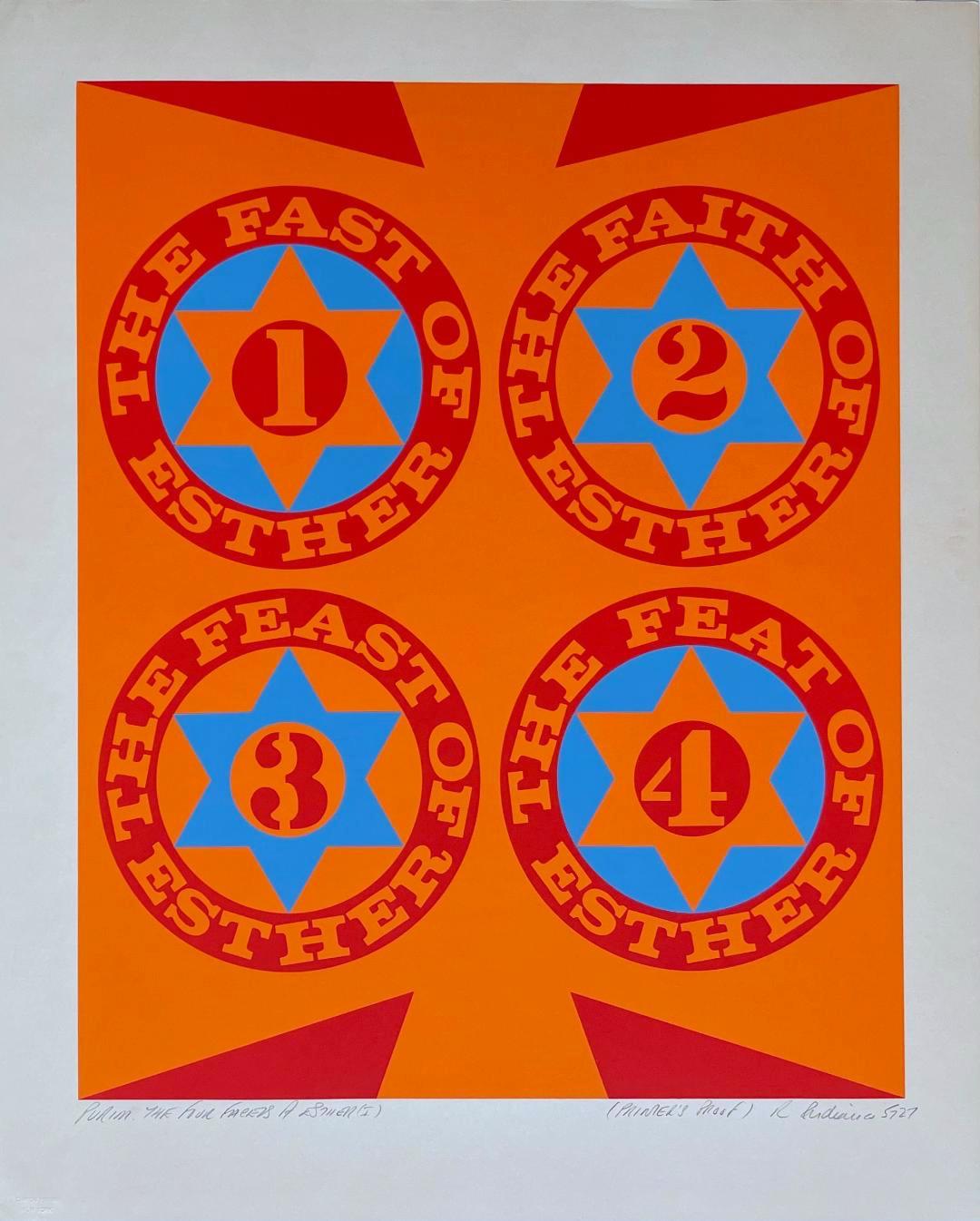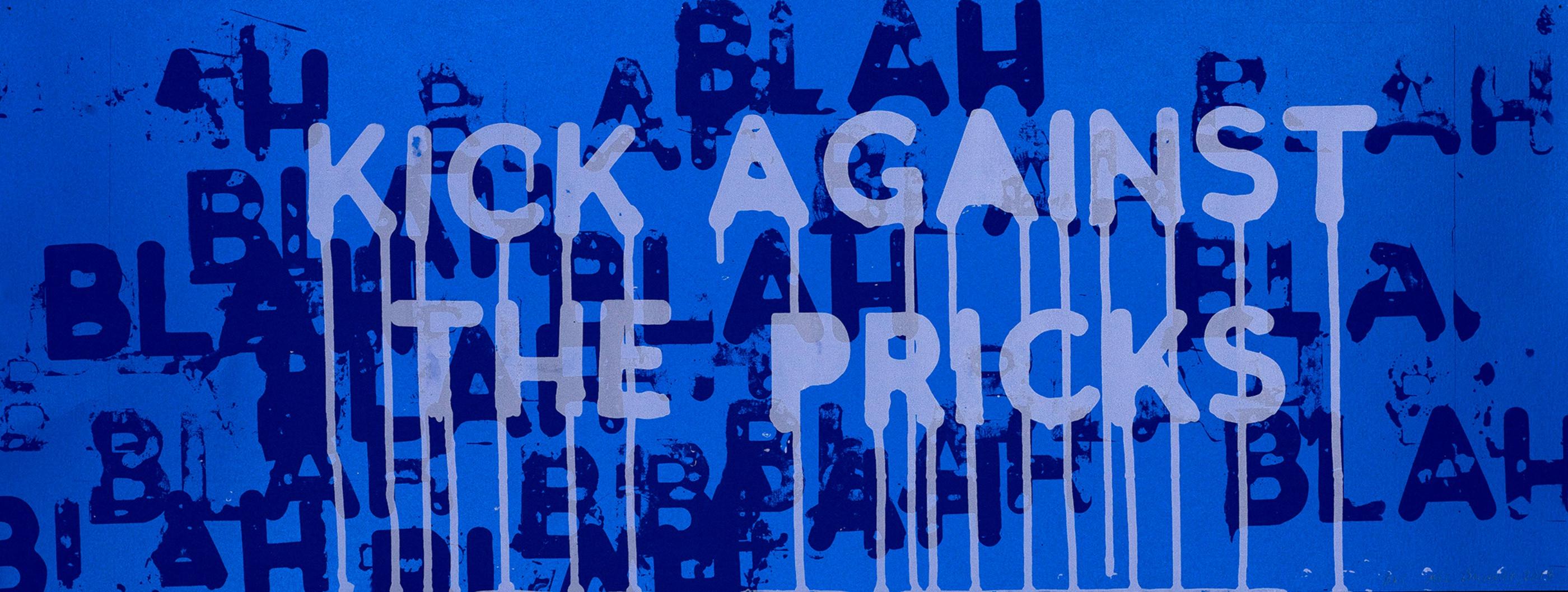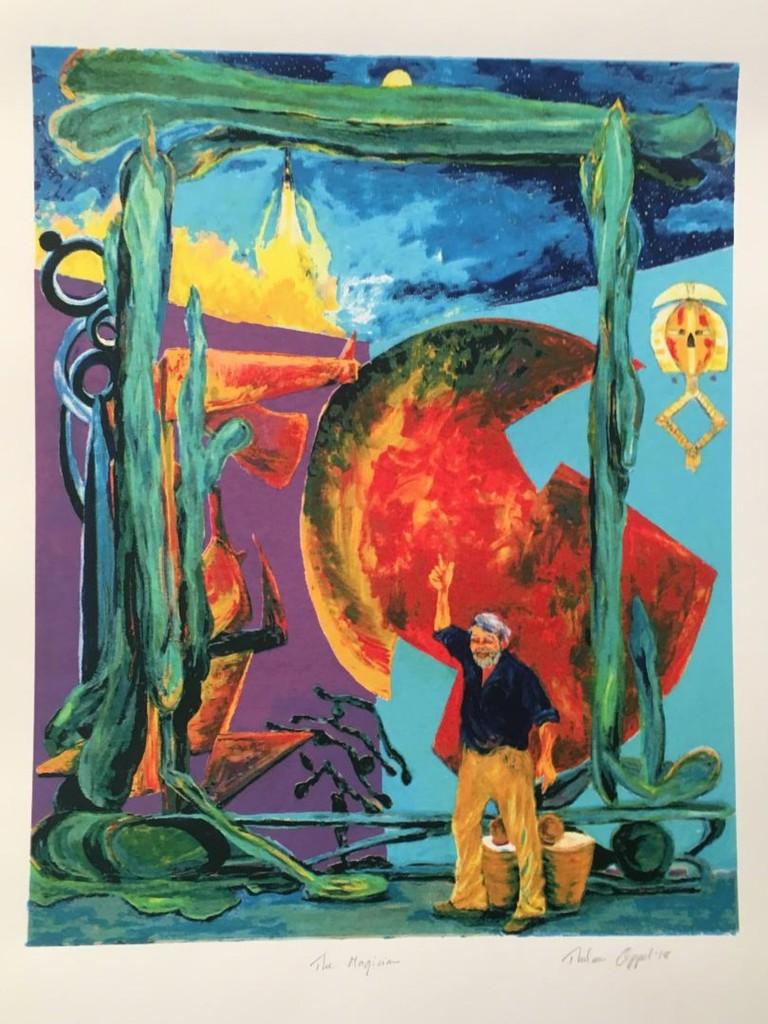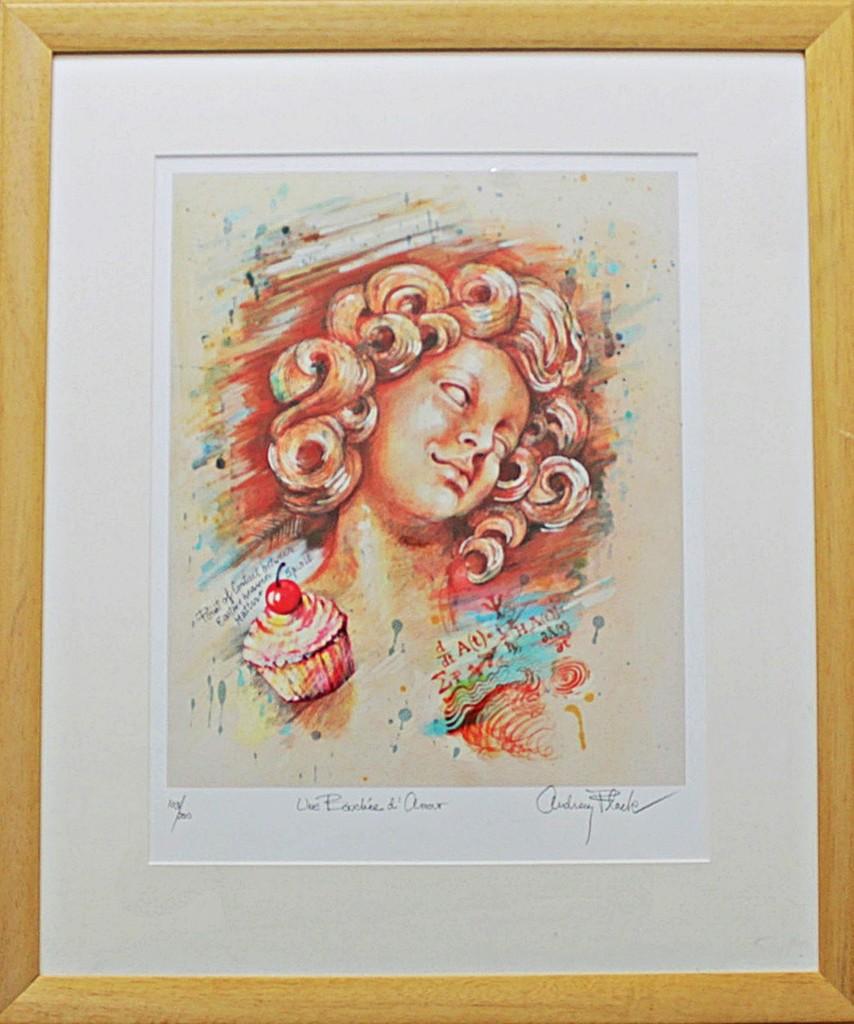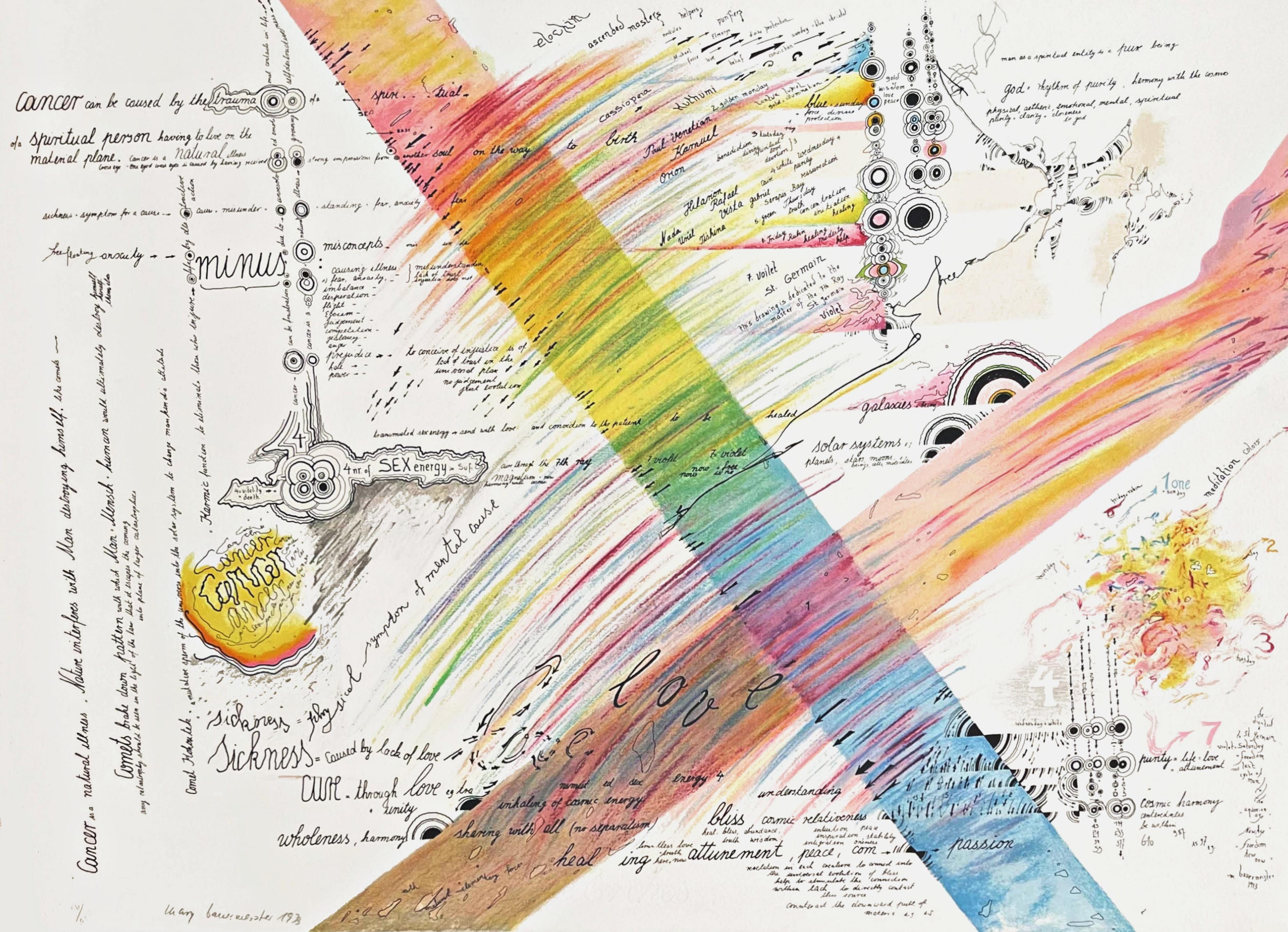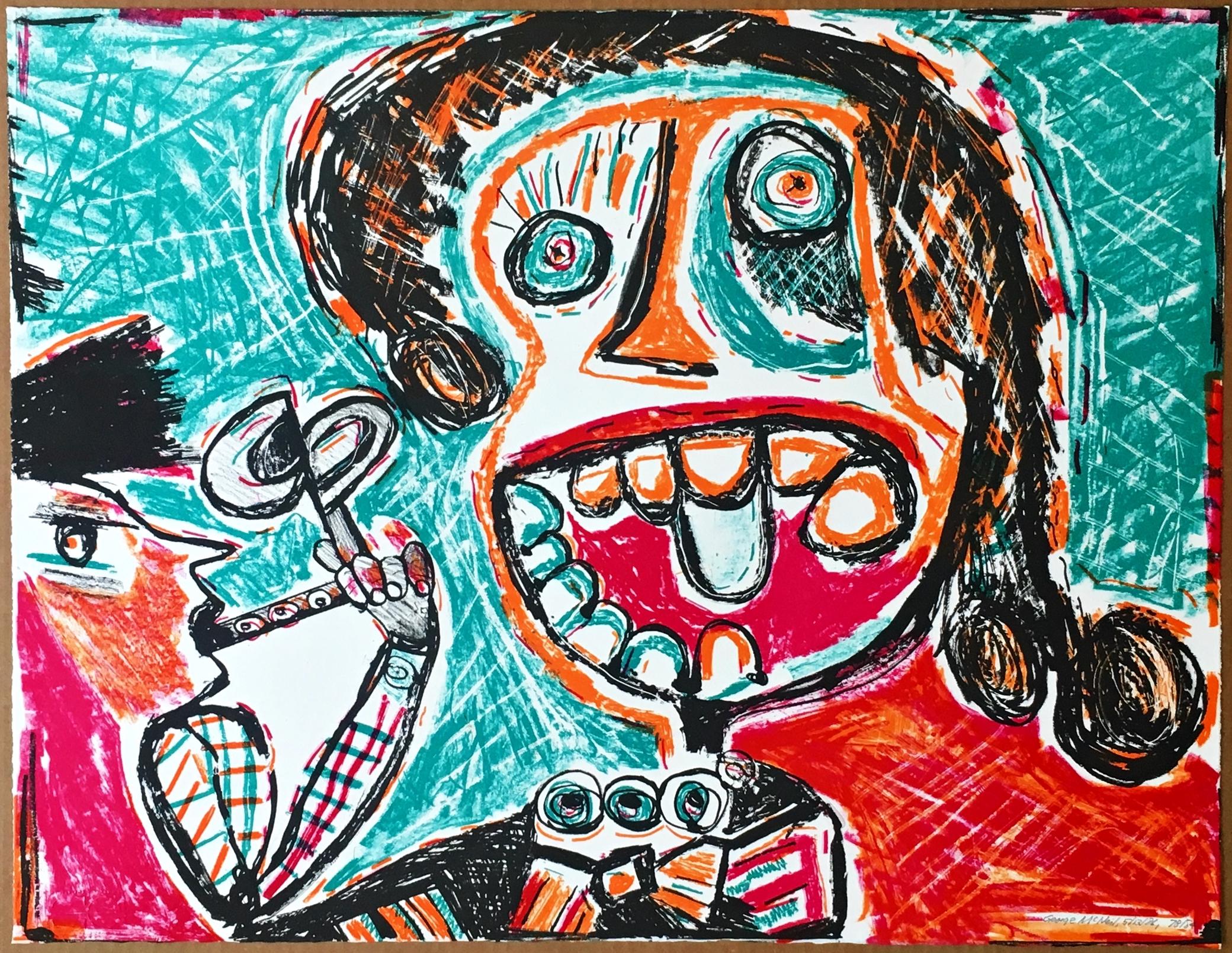Items Similar to I Rather Like You A Lot You Fool
Want more images or videos?
Request additional images or videos from the seller
1 of 11
Niki de Saint PhalleI Rather Like You A Lot You Fool1970
1970
About the Item
Niki de Saint Phalle
I Rather Like You A Lot You Fool, 1970
Silkscreen on wove paper
Signed and numbered 74//75 in graphite pencil on the front
Frame included
Signed and numbered 74//75 in graphite pencil on the front
A delightful and clever work. The text reads:
I Rather Like You A Lot You Fool
Not much Hair
Crooked Nose
You are not very rich
You’re not terribly intelligent
You smoke too much pot
You are lazy
A bit crazy
But I like the way you touch me
I like the way you look at trees and flowers
I like the way you look at me
You found the key to my heart
This work is elegantly floated and framed in a museum quality white wood frame with UV plexiglass
Dimensions:
Framed
23.5 vertical by 28.5 by 1.5 inches
Artwork:
19.5 by 25.5 inches
"Throughout her long and prolific career Niki de Saint Phalle, a former cover model for Life magazine and French Vogue, investigated feminine archetypes and women’s societal roles... Her Nanas, bold, sexy sculptures of the proverbial everywoman, are playful and empowering, while [her graphic works] offer humorous takes on girlhood obsessions..." - The Brooklyn Museum
Biography of Niki de Saint Phalle
Childhood
Niki de Saint Phalle was born in France in 1930 to an aristocratic Catholic family. She had an American mother, a French banker father, four siblings, and grew up bilingual in French and English. Her father lost his wealth during the Great Depression and the family moved to the US in 1933, where Saint Phalle attended Brearley School, a girls' school in New York City. Saint Phalle reported later in her life, in an autobiography titled Mon Secret (1994), that her father had sexually abused her from age 11.
From an early age, Saint Phalle pushed boundaries in her artistic and personal life. Though she found Brearley School to be a formative experience, later claiming that it was there she became a feminist, she was expelled for painting the fig leaves covering the genitals of statues on the school's campus red. She then attended Oldfields School in Maryland, graduating in 1947. As a young woman, Saint Phalle also worked as a model, appearing on the front covers of Life Magazine and Vogue.
When she was 18, Saint Phalle eloped with Henry Matthews, an author and childhood friend. While Matthews studied music at Harvard University, Saint Phalle began to explore painting, and gave birth to her daughter Laura in 1951, when she was 20 years old.
Early Training and work
In 1952, the Matthews and Saint Phalle moved to Paris, where he continued to study music and Saint Phalle studied theater. The couple traveled extensively in Europe, gaining exposure to art by the Old Masters. The following year, Saint Phalle was diagnosed with a "nervous breakdown" and hospitalized in a psychiatric facility. She was encouraged to paint as a form of therapy, and consequently gave up her theater studies in favor of becoming an artist.
The couple moved to Mallorca off the coast of Spain, where their son Philip was born in 1955. During this time, Saint Phalle developed her imaginative, self-taught style of painting, experimenting with a variety of forms and materials. She also discovered the architecture of Antonio Gaudi, which had a strong influence on her work. Gaudi's Park Guell in Barcelona was instrumental in Saint Phalle's early conceptualization of the elaborate sculpture garden she would fulfill much later in her career.
Mature Period
At the end of the 1950s, Saint Phalle and her husband moved back to Paris. In 1960, however, the couple separated and Saint Phalle moved to a new apartment, established a studio, and met artist Jean Tinguely, with whom she would collaborate artistically. Within a year, they had moved in together and begun a romantic relationship.
Saint Phalle became part of the Nouveau Réalisme movement along with Tinguely, Yves Klein, Arman and others. She was the only woman in the group. Her first solo exhibition in 1961 punctuated a dynamic period of Saint Phalle's early career, and she met a number of influential artists living in Paris at the time, such as Robert Rauschenberg and Jasper Johns, whose use of found objects was to have a strong influence on Saint Phalle's work. She was also friendly with Marcel Duchamp, who first introduced her and Tinguely to Salvador Dalí. The three artists traveled to Spain together to an event celebrating Dali's work, in which a life-sized bull sculpture was detonated with fireworks.
In 1963, Tinguely and Saint Phalle moved to an old house just outside Paris, where she began to work on architectural projects as well as her renowned shooting paintings. In 1971, she designed her first building (a residence in the south of France), traveled to India and Egypt to study Eastern architecture, and married Tinguely.
Her most famous and prolific series of works, the Nanas, were begun in the mid-1960s and inspired by a friend's pregnancy, her reflections on archetypal feminine forms, and the vexed positions that women occupy in modern, patriarchal societies. 'Nanas,' a French slang word roughly equivalent to 'broads,' is a title that encapsulates the theme of the everywoman as well as the casual denigration that closely accompanies the rhetorical grouping of women as a social category.
In 1974, Saint Phalle suffered from a serious lung illness and was advised by her doctors to spend some time in Switzerland to recuperate. While she was there, she met childhood friend Marella Caracciolo Agnelli, who was then the wife of Fiat chairman Gianni Agnelli. Marella was a well-connected socialite with a penchant for collecting art, and Saint Phalle told her about her vision of creating an elaborate sculpture garden of Tarot symbology. Caracciolo Agnelli proposed an area of land in Tuscany as a site, and initiated the garden work that would define the next 20 years of Saint Phalle's artistic efforts.
Late Period
In 1978, the foundations were laid for the Tarot Garden, and Saint Phalle created the first sculptural models for it. Construction began on the first large-scale sculpture in 1980, and in 1982 Saint Phalle completed The Empress, a sculptural building designed in the shaped of a sphinx. This structure became her studio and home for the next decade.
Saint Phalle was one of the first artists to get involved in AIDS outreach and prevention programs in the 1980s, designing prints to raise awareness about the disease. The 1980s were also the most prolific period in the Nanas series, and marked a time when her interests in the cultural and biological systems constructing femininity were their most intricately developed.
Jean Tinguely died in Switzerland in 1991, and Saint Phalle began to make a series of kinetic sculptures, his chief sculptural medium, to honor his memory. In 1994, Saint Phalle moved away from Tuscany to live in La Jolla in California. She lived there until her death in 2002.
The Legacy of Niki de Saint Phalle
The Nouveau Realisme movement, and Niki de Saint Phalle's work in particular, had a significant effect on the development of conceptual art. Her works often combined performance and plastic art in new ways, blending and dismantling hierarchies between painting, sculpture, and performance in a way that would influence conceptual artists such as Joseph Beuys and Lawrence Weiner. She performed some of her Shooting Pictures for Robert Rauschenberg, Jasper Johns, Ed Ruscha and Larry Bell, and influenced their thinking toward developing new and hybrid forms rather than refining single medium-specificity.
As a feminist, Saint Phalle's unique style championed the female body and female sexuality. Her work would inspire generations of women artists working with the problem and challenge of representing the female body (notably, Louise Bourgeois' ambiguous, supple fabric sculptures of female forms). Saint Phalle also left behind a significant legacy of public sculpture, both in her Tarot Garden in Tuscany and in other locations around the world.
-The Art Story
- Creator:Niki de Saint Phalle (1930-2002, French, American)
- Creation Year:1970
- Dimensions:Height: 23.5 in (59.69 cm)Width: 28.5 in (72.39 cm)Depth: 1.5 in (3.81 cm)
- Medium:
- Movement & Style:
- Period:
- Condition:
- Gallery Location:New York, NY
- Reference Number:1stDibs: LU1745214108182
About the Seller
5.0
Platinum Seller
These expertly vetted sellers are 1stDibs' most experienced sellers and are rated highest by our customers.
Established in 2007
1stDibs seller since 2022
289 sales on 1stDibs
Typical response time: 1 hour
- ShippingRetrieving quote...Ships From: New York, NY
- Return PolicyA return for this item may be initiated within 1 day of delivery.
More From This SellerView All
- Purim: The Four Facets of Esther (I) Sheehan, 36, Rare signed Printers Proof '66By Robert IndianaLocated in New York, NYRobert Indiana Purim: The Four Facets of Esther (I) Sheehan, 36, 1966 Color silkscreen on off white wove paper Printed by Stephen Poleskie, Chiron Press, New York. Published by The J...Category
1960s Abstract Geometric Abstract Prints
MaterialsScreen, Pencil, Graphite
- Kick Against the Pricks, Conceptual, Pop, Protest, Text Art, Signed/N - FramedBy Mel BochnerLocated in New York, NYMEL BOCHNER Kick Against the Pricks (Blah..Blah...Blah...), 2018 Two color silkscreen on boutique silk fair paper with blue-colored back, 350 gsm paper Signed, dated, and numbered lo...Category
2010s Conceptual Abstract Prints
MaterialsScreen, Graphite, Pencil
- The Magician homage to revered sculptor 18 Color silkscreen Signed, official COABy Thelma AppelLocated in New York, NYThelma Appel The Magician, 2018 18 Color Silkscreen on 320 gram Coventry Rag paper with deckled edges; accompanied by artist signed COA Signed twice: Pencil signed, titled and number...Category
2010s Contemporary Figurative Prints
MaterialsPencil, Screen, Graphite
- Une Bouchee D'Amour (signed presentation print by female photorealist artist)By Audrey FlackLocated in New York, NYAudrey Flack Une Bouchee D'Amour, 2013 Mixed media: Digitized drawing with silkscreen Signed, titled and numbered recto (front) in graphite pencil Annotated presentation proof Frame included: in elegant vintage wood frame Print Club of New York, Publisher; Printer: Experimental Printmaking Institute, Lafayette College, Easton, PA Digitized drawing with silkscreen Flack's "Une Bouchee d'Amour" was the 2013 presentation print commissioned by The Print Club of New York, and it is accompanied by a COA issued by the Print Club of NY as well as Alpha 137...Category
2010s Photorealist Abstract Prints
MaterialsMixed Media, Digital, Screen, Pencil, Graphite
- Rainbow Signed 1970s silkscreen & lithograph by pioneering female Fluxus artistBy Mary BauermeisterLocated in New York, NYMary Bauermeister Rainbow, 1973 Lithograph and silkscreen on creamy white paper Hand signed, dated and numbered 56/250 by the artist on the front 19 x 25.5 inches Unframed This work is on the permanent collection of various institutions like: Rice University, Samuel Dorksy Museum of Art, Rutgers Zimmerli Museum and Wheaton College Massachusetts. While studying the fringe sciences the 1970s, Bauermeister created Rainbow (1973), a lithograph and silkscreen. She uses a creamy white background as the base. Two intersecting diagonal bands of color transcend across the page, and black cursive lettering dances over the surface serving as a mind map of interweaving ideas. Through the central band, Bauermeister shifts through the color spectrum; she begins with red and finishes with violet. Inspired by music, she uses strokes of color that are rhythmically smeared across the lithograph. The surface lettering, a kind of visual poetry, explores her interest in human emotion and science. The viewer can see Bauermeister’s thoughts as they flow into one another through the use of words such as bliss, love, and healing. Bauermeister also includes a repetition of words such as cancer, sickness, and cure. The word cancer emerges from a cell-like shape. A careful study of the words shows that they may seem dark in nature; however, she juxtaposes these words against the cheerful title and colors. Perhaps the rainbow symbolizes a new hope, an inspiration for an optimistic future. -Courtesy to the Samuel Dorsky Museum of Art About Mary Bauermeister: A multidisciplinary artist known for her intricate and enigmatic assemblages, Mary Bauermeister (1934-2023) continues to defy categorization with layered works in a range of media. A precursory figure of the Fluxus movement—her studio was the meeting point for a number of defining artists of the avant-garde—her work plays an integral role in the discussion of art, both European and American, that emerged from the 1960s. Her reliefs and sculptures, which have incorporated drawing, text, found objects, natural materials and fabric, reference a plethora of concepts: from natural phenomena and astronomy to mathematics and language, as well as her own “spiritual-metaphysical experiences.” Maturing amidst the currents of Minimalism and Pop Art, Bauermeister’s art has resisted labels due to the singular expression of her interests and concerns, among them the simultaneous transience and permanence of the natural world with experimentations in transparency and magnification, multiplication and variation, structure and order, chance and ephemerality, introversion and extroversion. Her three-dimensional receptacles of thoughts, ideas, and notes contain visual, conceptual, and philosophical paradoxes that challenge perceptions and that offer literal and metaphorical windows into which one can glimpse the inner workings of the artist’s mind. - Courtesy of Michael Rosenfeld...Category
1970s Modern Abstract Prints
MaterialsLithograph, Screen, Mixed Media, Pencil, Graphite
- Untitled Figure signed numbered mixed media print from scarce European portfolioBy George McNeilLocated in New York, NYGeorge McNeil Untitled Figure, 1986 Lithograph on paper. Publisher's and Printer's Blind Stamps Hand-signed, numbered 78/84 and dated by the artist on the front with publisher's and...Category
1980s Abstract Expressionist Figurative Prints
MaterialsLithograph, Pencil, Screen
You May Also Like
- Geometric Woman's Portrait - Rare Signed Graphite Drawing on Paper 1962Located in Soquel, CAGeometric Woman's Portrait - Rare Signed Graphite Drawing on Paper 1962 Beautiful, soft original drawing by Eugene Hawkins (American, b. 1933). A realistic depiction of a short-haired woman, her large lips parted into a soft smile. She's surrounded in geometric shapes offering a wonderful juxtaposition to the natural curves of her face and hair. Signed in pencil, "Eugene Hawkins '62" Presented in a new black mat. Mat size: 20"H x 16"W Paper size: 18.5"H x 14.5"W Eugene Hawkins (American, b. 1933) is a BIPOC artist known for his detailed portraiture and printmaking. He is listed in Who Was Who in American Art, 1564-1975, and his work was exhibited in the Whitney Museum of American Art. He spent the majority of his life working and exhibiting in Southern California. His work frequently touches upon socio-political subjects, making strong statements about the world. The California African American Museum features Eugene Hawkins's work in the Permanent Collection. Exhibition: 2017 Paperworks: Selections from the Permanent Collection focuses on works on paper produced from 1950-2000 and includes figurative, impressionistic, and abstract styles. The exhibition showcases the radically diverse range of works on paper created by African American and other artists over the last two centuries, and includes drawings, prints, paintings, and collages by Edward Mitchell Bannister...Category
1960s American Modern Figurative Prints
MaterialsGraphite, Paper
- Waving the flagLocated in Llanbrynmair, GB’Waving the Flag’ By Kip Gresham Medium - Screen Print Edition - 21/24 Signed - Yes Size - 515mm x 645mm Date - 1986 Condition - Very good. 8 out of 10. Col...Category
1980s Abstract Abstract Prints
MaterialsScreen
- A qualcuno piace caldoBy Mimmo RotellaLocated in Ljubljana, SIA qualcuno piace caldo (eng. Some like it hot). Original color silkscreen and collage on canvas, unknown year. Edition of 100 signed and numbered impressions on Arches paper. Mimmo R...Category
Late 20th Century Abstract Abstract Prints
MaterialsMixed Media, Color, Screen
- Otono Floral (Sexual Spring-like Winter)By Julian SchnabelLocated in New York, NYOtono Floral, 1995 Hand-painted, 15-color screenprint with poured resin 40 x 30 inches (102 x 76 cm) Edition of 80 signed in pencil and stamped on verso "Sexual Spring-like Win...Category
1990s Abstract Expressionist Abstract Prints
MaterialsScreen
- Invierno Primaveral (Sexual Spring-like Winter)By Julian SchnabelLocated in New York, NYJulian Schnabel Invierno Primaveral, 1995 Hand-painted, 17-color screenprint with poured resin 40 x 30 inches (102 x 76 cm) Edition of 80 signed in pencil and stamped on verso ...Category
1990s Abstract Abstract Prints
MaterialsScreen
- Adam Pendleton - Mask, Screenprint, Black Dada, Contemporary Art, Signed PrintBy Adam PendletonLocated in Hamburg, DEAdam Pendleton (American, b. 1984) Mask (Collector’s Edition), 2020 Medium: Screenprint on paper (410 gsm) inkl. artist book Dimensions: 27.9 x 24.1 cm (11 x 9.5 in) Edition of 50: H...Category
21st Century and Contemporary Abstract Abstract Prints
MaterialsScreen
